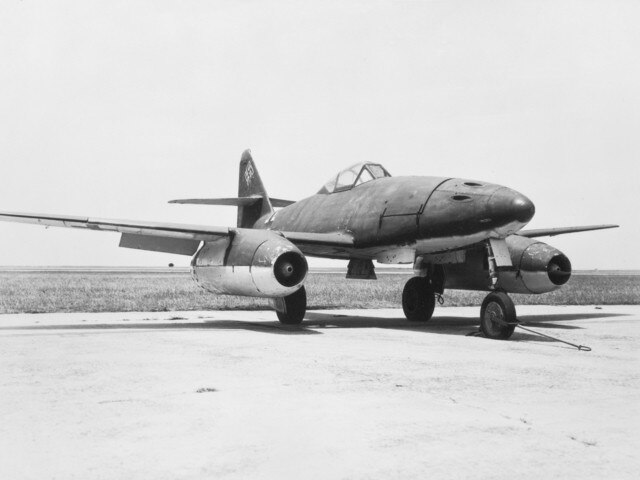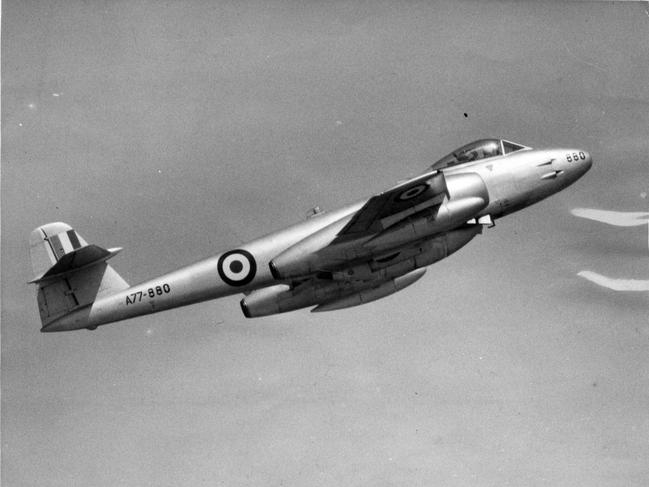The pilots who took on Hitler’s airpower
As Nazi Germany made its last desperate attempts to continue its reign of terror in Europe, brave Queensland airmen risked their lives shooting down a weapon that would change the course of history.
News
Don't miss out on the headlines from News. Followed categories will be added to My News.
AS Nazi Germany made its last desperate attempts to continue its reign of terror in Europe, brave Queensland airmen risked their lives shooting down a weapon that would change the course of history.
Seventy-five years ago The Courier-Mail reported that Queensland Spitfire pilots had “again been in the forefront of the battle against German jet planes over Europe’’.
The Queenslanders were going up against the extraordinary Messerschmitt 262, the world’s first operational jet fighter.
On April 7, 1945, we reported: “Recently, Warrant Officer V. J. Rossow, of Nanango, flying one of the latest five-blade propeller Spitfires was on patrol when he saw a Messerschmitt 262 jet aircraft.
“I closed in on him and gave him a long burst,’’ Rossow said. “I noticed strikes around his wing and tailplane, but he streaked away before I had time to get to another shot.
“With Flying Officer E. Gray, of Toowoomba, Rossow then climbed to 6000ft (1800m). Gray noticed another jet aircraft 1000ft below and dived on it.

“I saw the flashes of my bullets hitting the cockpit of the jet,” said Gray, “and saw the jet, apparently out of control, falling through cloud.’’
Jet aircraft had their genesis in 1933 in the brain of young German physics student Hans von Ohain. While they revolutionised air travel for the whole world, they were a product of war.
Plans for the Messerschmitt jet fighter were first submitted in April 1939 and the Me 262, known as the Swallow, first flew in July 1942, almost nine months ahead of the British jet, the Gloster Meteor.
Reports filtered to Australia that the “262 is a single-seater, low-wing monoplane with two underslung turbojet nacelles designed by Junkers. The wingspan is about 40 feet (13m) and it has a prominent fin and rudder.’’
Germans claimed the 262’s top speed was 1100km/h, but Australian newspapers assured readers that Allied aircraft, led by the Spitfire, had much more bite even if they were slower.
In October 1944 Australian readers learned: “The more frequent appearance of the Messerschmitt 262 German jet-propelled plane over Holland and northwest Germany indicates the importance the enemy is attaching to the Luftwaffe’s newest weapon. At present, however, the plane is by no means a menace to our fighters.

“In fact, when sighted it usually makes off at high speed, refusing combat. Obviously its unwillingness to fight is due largely to lack of experience in handling the plane.
“RAF pilots say it has tremendous speed and a high climb rate, but the German pilots do not appear able to manoeuvre or turn fast.’’
Before long The Courier-Mail told readers the Nazis were so desperate that “special squadrons of German jet-propelled fighters’’ were being used as ramming planes in a bid to break up Allied bomber formations before they were able to reach German targets.
“Pilots with all their guns blazing … aim their aircraft at the nearest bomber and lock controls. At the last second they press a lever, and are automatically freed by a device which catapults the cockpit cover, their seat, and themselves clear of their aircraft.’’
About 1400 Me 262s were produced, with much of the work done by inmates at the horrific Mauthausen-Gusen concentration camp in Austria.
It is estimated as many as 50,000 people died there on forced work details for the aircraft.
Messerschmitt 262 pilots claimed a total of 542 Allied aircraft shot down.
The Me 262 on display at the Australian War Memorial in Canberra was built at Regensburg in March 1945 and is said to be the only one in existence with its original paintwork.
grantlee.kieza@news.com.au
Grantlee Kieza’s best-selling biography of Bundaberg aviator Bert Hinkler is published by HarperCollins/ABC Books
Originally published as The pilots who took on Hitler’s airpower


